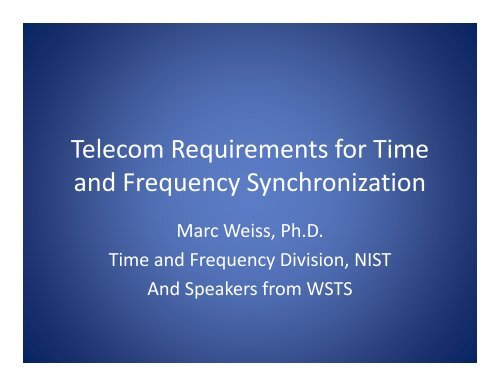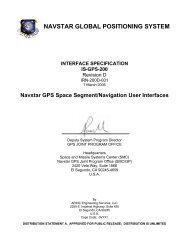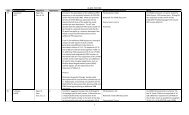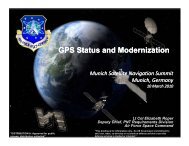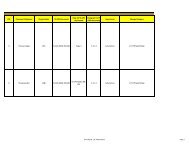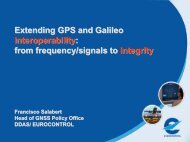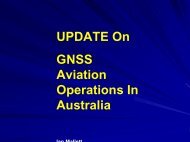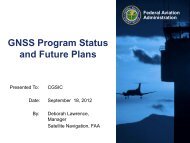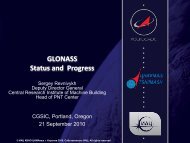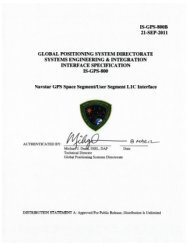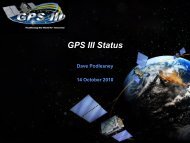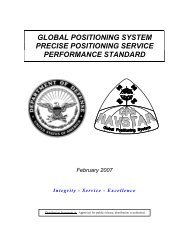Telecom Requirements for Time and Frequency ... - GPS.gov
Telecom Requirements for Time and Frequency ... - GPS.gov
Telecom Requirements for Time and Frequency ... - GPS.gov
Create successful ePaper yourself
Turn your PDF publications into a flip-book with our unique Google optimized e-Paper software.
<strong>Telecom</strong> <strong>Requirements</strong> <strong>for</strong> <strong>Time</strong><strong>and</strong> <strong>Frequency</strong> SynchronizationMarc Weiss, Ph.D.<strong>Time</strong> <strong>and</strong> <strong>Frequency</strong> Division, NISTAnd Speakers from WSTS
Outline• Evolution of Sync– SONET/SDH– Packet-based networks• Mobile St<strong>and</strong>ards <strong>and</strong> Sync• LTE-Advanced• E911• Conclusions
Excerpts from WSTS• The NIST-ATIS-Telcordia Workshop on Synchronization in<strong>Telecom</strong> Systems– Occurs annually since 1992– Much of the content here is directly reproduced from WSTStalks given by experts in their field• WSTS <strong>and</strong> its European sister ITSF represent a globalalliance of pre-eminent experts in synchronization <strong>for</strong>telecom <strong>and</strong> related applications. Many of these expertsact as steering group members <strong>for</strong> both conferences, aswell as sit on various st<strong>and</strong>ards bodies including ITU, ATIS<strong>and</strong> IETF.
Evolution of <strong>Telecom</strong> Sync• Formerly, the network was “synchronous” (reallysyntonous!)– Data transport required same frequency distributed throughdifferent quality of clocks call strata– The same b<strong>and</strong>width was used <strong>for</strong> data transport betweennodes, independent of traffic• The network has evolved to have an asynchronous, orpacket, core, with access technologies such as wireless cellnetworks at the edge– Packet data does not require syntonization, <strong>and</strong> uses scalableb<strong>and</strong>width– Syntonization <strong>and</strong> now true synchronization is now required <strong>for</strong>services <strong>and</strong> apps at the edge of the network <strong>and</strong> <strong>for</strong> users
<strong>Telecom</strong> Receivers are GenerallyStationary, Used <strong>for</strong> <strong>Time</strong> <strong>and</strong><strong>Frequency</strong> OnlyExample of NIST receiver is similar
SONET/SDH Systems• Synchronous Optical NETwork developed <strong>and</strong>deployed in the US <strong>and</strong> Canada in the 80’s <strong>and</strong>90’s• Synchronous Digital Hierarchy generalizes SONETin that it is the <strong>for</strong>m in ITU-T <strong>and</strong> used throughoutthe world besides N. America• SONET/SDH are transport systems still in use thatrequire frequency synchronization– Data <strong>and</strong> voice can be carried over SONET/SDH– Packet data can be carried over SONET/SDH
Packet-Based Networks• The physical layer can be Ethernet, or othersystem that does not require sync– This allows variable b<strong>and</strong>width <strong>and</strong> more scalablesystems– However services still require various kinds of sync<strong>and</strong> the network requires special transport systems todeliver that• Many network elements obtain sync from <strong>GPS</strong><strong>and</strong> other GNSS– These signals are vulnerable to interference– ITU-T <strong>and</strong> other st<strong>and</strong>ards bodies have on-going workto st<strong>and</strong>ardize sync transport over packet
Timing Technology: <strong>Frequency</strong>• <strong>Frequency</strong> accuracy (FFO) is thedifference in frequency betweenthe server clock <strong>and</strong> the recoveredclient clock over a time interval• <strong>Frequency</strong> targets– ± 32 ppm <strong>for</strong> Stratum 4 & 4E– ± 4.6 ppm <strong>for</strong> Stratum 3 & 3E– ± 50 ppb <strong>for</strong> GSM & WCDMA-FDD– ± 100 ppb <strong>for</strong> Home NodeBAccuracy<strong>Frequency</strong> (ppm)Slave Clock<strong>Frequency</strong>AccuracyMasterClock<strong>Time</strong> (s)Thanks to Adam Wertheimer, Microsemi Co. <strong>for</strong> the use of this slide.© 2011 Microsemi Corporation.
Timing Technology: Phase• Alignment <strong>and</strong> PPS• Phase alignment is in addition tophase lock. Phase alignment alsoreferred to as Latency Correction.• Phase alignment has– Bounded phase offset between serverclock <strong>and</strong> recovered client clock– Bounded phase offset between differentrecovered client clocks• Phase alignment requires bi-directionalmechanism• Phase alignment targets– ± 1.25 µs <strong>for</strong> WCDMA-TDD– ± 3 µs <strong>for</strong> CDMA2000, CDMAone– ± 1 µs <strong>for</strong> WiMAX0 1Master Clock2Slave Clock 15 6 7Slave Clock 21 2 3Thanks to Adam Wertheimer, Microsemi Co. <strong>for</strong> the use of this slide.© 2011 Microsemi Corporation.
SONET/SDH <strong>Frequency</strong> SyncStrata 4 <strong>and</strong> 4E support 32 ppmClock DesignationLong TermAccuracy(± PPM)Holdover Stability(± PPM)Free-RunSTS Pointer GenerationHoldoverSTS Pointer GenerationStratum 1 .00001 N/A 1 every 4.3 hours N/AStratum 2 .016 .0001 1 every 9.6 sec 1 every 25.72 minStratum 3E 4.6 0.012 29.81 /sec 1 every 12.86 secStratum 3 4.6 0.37 29.81/sec 2.39 /secSMC 20 4.6 129.60 /sec 29.81 /secStratum 4E 32 N/A 207.36 /sec N/AStratum 4 32 N/A 207.36 /sec N/ANote:1. STS pointer generation relative to 0 ppm.2. 1 STS pointer is equivalent to a one-way phase movement of 154 ns.3. Pointer generation reflects the maximum frequency offset per clock type.4. Long-term accuracy is also known as free-run accuracy.5. SONET payload integrity guaranteed to +/- 4.6 ppm (bold red)
<strong>GPS</strong>/GNSS meets Stratum 1 <strong>Requirements</strong>with a Good Local Oscillator• Stratum 1 requires 10 -11 frequency accuracy– 10 ns at 15 minutes, 100 ns at 3 hours– This is 0.01 ppb• Maybe beyond a Qu, achievable with a CSACor Rb Oscillator• Holdover is an important consideration
Current status of ITU-T St<strong>and</strong>ards <strong>for</strong> PacketTiming in <strong>Telecom</strong>Thanks to Jean-Loup Ferrant, Calnex, Q13/15 Rapporteur, <strong>and</strong> Stefano Ruffini, Ericsson, Q13/15 Associate Rapporteur
<strong>Time</strong> Synchronization via PTP• The basic principle is to distribute <strong>Time</strong> sync referenceby means of two-way time stamps exchangeMS<strong>Time</strong> Offset= t 2 – t 1 – Mean path delayMean path delay = ((t 2 – t 1 ) + (t 4 – t 3 )) /2t 1t 2t 3t 4• As <strong>for</strong> NTP, also in case of PTP Symmetric paths arerequired:– Basic assumption: t 2 – t 1 = t 4 – t 3– Any asymmetry will contribute with half of that to theerror in the time offset calculation (e.g. 3 µs asymmetrywould exceed the target requirement of 1.5 µs)Slide thanks to WSTS – 2011, Stefano Ruffini, Ericsson , Q13/15 Associate Rapporteur
Is “full IEEE 1588 support” goodenough ?• Removal of PDV <strong>and</strong> asymmetry in the nodes by means ofIEEE1588 support (e.g. Boundary Clock in every node).PRTCPTPMasterT-BC T-BC . . . T-BC SOOCEndAppPRTC : Primary Reference <strong>Time</strong> ClockT-BC: <strong>Telecom</strong> - Boundary ClockSOOC: Slave Only Ordinary Clock› Ideally the full support can provide very accurate timing,however several sources of errors still remainsSlide thanks to WSTS – 2011, Stefano Ruffini, Ericsson , Q13/15 Associate Rapporteur
Current <strong>Frequency</strong> Sync <strong>Requirements</strong>from ATIS TR on Intra-Office Networks<strong>Frequency</strong> Applications <strong>and</strong> use cases (based on G.8261 appendix IV)• Existing network where a free-run accuracy of +/-32 ppm is needed<strong>for</strong> end-equipment. Slips may become a problem. These slips mayinterfere with voice-b<strong>and</strong> modem communications.• If the system also supports SONET, then an accuracy of better than+/- 4.6 ppm is needed.• Wireless technologies.– +/-50 ppb <strong>for</strong> GSM (<strong>and</strong> other related technology) base stations– +/-16ppb In some cases, this requirement is tightened– Based on 3GPP TS25.105 <strong>and</strong> TS36.101, frequency requirements thatmay apply in addition to the phase requirements :• ±50 ppb <strong>for</strong> wide-area base stations• 100 ppb <strong>for</strong> local-area base stations• 250 ppb <strong>for</strong> home base stationsThanks to Adam Wertheimer, Microsemi Co. <strong>for</strong> this in<strong>for</strong>mation.
Current <strong>and</strong> Evolving <strong>Time</strong> Sync <strong>Requirements</strong>from ATIS TR on Intra-Office Networks• Phase Applications <strong>and</strong> use cases (based on G.8271appendix II)– 1 ms to 500 ms <strong>for</strong> billing <strong>and</strong> alarm collection systems. It iscommon to use NTP <strong>for</strong> this application.– For IP delay monitoring, an accuracy of up to 5 microseconds isneeded.– LTE-TDD <strong>and</strong> CDMA-based wireless systems need an accuracy of1.5 – 5 microseconds.– UTRA-TDD <strong>and</strong> LTE-TDD (small cell) need an accuracy of 1 – 1.5microseconds.– In some configurations, WiMAX-TDD <strong>and</strong> LTE-A have additionalrequirements below 1 microsecond.– A feature in LTE-A may require time sync below 1 microsecond(discussed later)Thanks to Adam Wertheimer, Microsemi Co. <strong>for</strong> this in<strong>for</strong>mation.
<strong>Requirements</strong> from ITU-T Q13/15Current Status
Meeting Sync <strong>Requirements</strong> in <strong>Telecom</strong>• UTC accuracy <strong>and</strong> stability brought into network generallywith GNSS <strong>and</strong> local oscillator– Short term stability depends on local oscillator– Hold-over also depends on local oscillator– E.g. holding 1 microsecond <strong>for</strong> a day cannot be done with a Quoscillator• GNSS requires an antenna <strong>and</strong> sky view. Vulnerability is anissue• <strong>Time</strong> <strong>and</strong> frequency sync is often spread from the receiverthrough the network– Network elements add noise <strong>and</strong> errors in various <strong>for</strong>ms– Passing 1 microsecond time sync is hard, limited by distance
Excerpts from:Mobile st<strong>and</strong>ards & synchronization:3GPP, etc.WSTS - 2012Stefano Ruffini, Ericsson
Evolution of mobile technologiesGSM Track (3GPP)GSM WCDMA HSPATD-SCDMACDMA Track (3GPP2)CDMA One EVDO Rev ALTEFDD <strong>and</strong> TDD2001 2005 2008 2010
Mobile applications <strong>and</strong>Synchronization• The needs of Transport <strong>and</strong> switching networks havebeen the main drivers <strong>for</strong> sync st<strong>and</strong>ardization in the90s– Mobile applications only as side users (e.g. SynchronousPDH signals are used to synchronize the GSM network infrequency)• The needs of Mobile networks are now the maindrivers of the sync st<strong>and</strong>ardization activities in ITU-T:– Several bodies where synchronization is a key topic (3GPP,MEF, BBF, NGMN)• Discussions between ITU-T <strong>and</strong> 3GPP on the syncaspects not always easy:– Use of different terminologies– Different focus
3GPP: 3rd Generation PartnershipProject• 3GPP was created in December 1998. Currently 6 Partners.• “The purpose of 3GPP is to prepare, approve <strong>and</strong> maintain globally applicableTechnical Specifications <strong>and</strong> Technical Reports <strong>for</strong>:– an evolved 3rd Generation <strong>and</strong> beyond Mobile System based on the evolved3GPP core networks, <strong>and</strong> the radio access technologies supported by the Partners(i.e., UTRA both FDD <strong>and</strong> TDD modes), to be transposed by the OrganizationalPartners into appropriate deliverables (e.g., st<strong>and</strong>ards).– the Global System <strong>for</strong> Mobile communication (GSM) including GSM evolved radioaccess technologies (e.g. General Packet Radio Service (GPRS) <strong>and</strong> Enhanced Datarates <strong>for</strong> GSM Evolution (EDGE)).– an evolved IMS developed in an access independent manner.”(From “3GPP Scope <strong>and</strong> Objectives Approved by 3GPP Organizational Partnersby correspondence 31 August 2007”)
CDMA 2000 Synchronization<strong>Requirements</strong>3GPP2 C.S0010-B: Recommended Minimum Per<strong>for</strong>mance St<strong>and</strong>ards<strong>for</strong> cdma2000 Spread Spectrum Base Stations3GPP2 C.S0002-C: Physical layer st<strong>and</strong>ard <strong>for</strong> cdma2000Spread Spectrum Systems• <strong>Time</strong> Synchronization <strong>Requirements</strong>–± ± 3 µs with respect to CDMA System <strong>Time</strong>(which is traceable <strong>and</strong> synchronous to UTC)–± 10 µs with respect to CDMA System <strong>Time</strong> <strong>for</strong> a periodnot less than 8 hours(when the external source of CDMA system time isdisconnected)<strong>GPS</strong> Receiver is typically deployed at every Base Station
Additional sync requirements <strong>for</strong> TDD2ms5ms5µs1ms10 msmodePhase Synchronization (Radio Interface) requirements are defined in TS 25.402These apply to UTRA-TDD systems (e.g. TD-CDMA, TD-SCDMA)…256 sThe relative phase difference of the synchronizationSignal shall not exceed 2.5 µs (3 µs is mentioned <strong>for</strong> TD-SCDMA)External sync Source (e.g. <strong>GPS</strong>)Sync inNode BNode BSync inNode BSync outSync inSync outThe <strong>Requirements</strong> is +/-1.25 µs <strong>for</strong> independent inputs to the NodeBs
WCDMA Base Station TX <strong>Frequency</strong> ErrorTS 25.104/5:“Base Station (BS) radio transmission <strong>and</strong> reception (FDD/TDD)”<strong>Frequency</strong> Synchronization requirements (on the Radio Interface)are specified in 3GPP TS 25.104 (FDD), <strong>and</strong> TS 25.105 (TDD)The Base Station shall use the same frequency source <strong>for</strong> both RF frequencyGeneration <strong>and</strong> the chip clock .The modulated carrier frequency is observed over a period of one timeslot <strong>for</strong> RFfrequency generationBS classWide Area BSMedium Range BSLocal Area BSHome BSAccuracy±0.05 ppm±0.1 ppm±0.1 ppm±0.25 ppmY < 0.05-0.1 ppmNodeBThe requirement applies on the radio interface
LTE Base Station TX <strong>Frequency</strong> ErrorTS 36.104: “Evolved Universal Terrestrial Radio Access(E-UTRA); Base Station (BS) radio transmission <strong>and</strong> reception• <strong>Frequency</strong> Synchronization (Radio Interface) requirements:– The same source shall be used <strong>for</strong> RF frequency <strong>and</strong> data clock generation.– The modulated carrier frequency of the BS observed over a period of one subframe (1ms)shall be accurate to withinBS classAccuracyY < 0.05-0.25 ppmWide Area BSLocal Area BSHome BS±0.05 ppm±0.1 ppm±0.25 ppmeNodeB<strong>Requirements</strong> at the input of the eNodeB depends on the actual implementation(<strong>for</strong> instance network limits are defined in case the frequency reference is distributed overthe physical layer, TDM or Synchronous Ethernet)The requirement applies on the radio interface
LTE-TDD Phase Synchronization<strong>Requirements</strong>TS 36.133: “Evolved Universal Terrestrial Radio Access(E-UTRA); <strong>Requirements</strong> <strong>for</strong> support of radio resource managementTS 36.922: “Evolved Universal Terrestrial Radio Access (E-UTRA);TDD Home eNode B (HeNB) Radio <strong>Frequency</strong> (RF) requirements analysis”LTE-TDD(Wide-Area BasestationLTE-TDD(Home-Area Basestation)LTE-TDD to CDMAh<strong>and</strong>overs(Synchronized E-UTRAN)Maximum absolute deviation in frame start timingbetween any pair of cells on the same frequency that haveoverlapping coverage areas- 3usec <strong>for</strong> small cell (< 3km radius),- 10usec <strong>for</strong> large cell ( > 3km radius)- 3 usec <strong>for</strong> small cell (< 500m radius).- 1.33 + Tpropagation µs, <strong>for</strong> large cell (> 500m radius),Tpropagation: propagation delay between the Home BS <strong>and</strong> the cellselected as the network listening synchronization source- eNodeB shall be synchronized to <strong>GPS</strong> time.- With external source of CDMA system time disconnected, theeNodeB shall maintain the timing accuracy within ± 10usec of CDMAsystem time <strong>for</strong> a period of not less than 8 hours
Excerpts from:Deutsche Telekom<strong>Time</strong>/Phase Synchronization <strong>Requirements</strong><strong>for</strong> LTE-Advanced Wireless Systems includingCoMPDeutsche Telekom at WSTS 2011Helmut Imlau, Heinz Droste
CoMP introduction (1/2)CoMP = Coordinated Multi-Point Transmission <strong>and</strong> Reception, with two categories:(1) Coherent Joint Processing (JP), aka “Network MIMO” <strong>and</strong>(2) Coordinated Scheduling (CS).CoMP - Joint Processing Transmission <strong>and</strong>/or reception from/togeographically separated antennas.Traffic <strong>and</strong> control data transferbetween eNB via X2 interface (logicalinterface).eNBSectorsSiteUser terminalSee Figure:Idea of JP is communication between oneuser terminal<strong>and</strong> several eNB sectors at the same time.eNBX2eNB10.05.2011– LTE-A <strong>Time</strong> <strong>and</strong> phase sync requirements –Deutsche Telekom at WSTS 201129
CoMP introduction (2/2)CoMP = Coordinated Multi-Point Transmission <strong>and</strong> Reception, with two categories:(1) Coherent Joint Processing (JP), aka “Network MIMO” <strong>and</strong>(2) Coordinated Scheduling (CS)CoMP - Coordinated Scheduling (CS) Dynamic allocation of air interface resourcesin overlapping cells. Control data exchange between eNB (incl.Pico-eNB) via X2 interface(X2 <strong>for</strong> control data only).eNBSectorsSiteThe decision must be made right in time,which eNB / which resource is going to serve whichuser terminal, depending on user terminal location,b<strong>and</strong>width requirement <strong>and</strong> speed.eNBeNBCoordinated Scheduling options:Pico-eNBX2=> decentralized per cooperation cluster or=> centralized (per super cell => fixed number of cells that cooperateincluding several cooperation clusters). Every user is served by its "Serving Cell" only.10.05.2011– LTE-A <strong>Time</strong> <strong>and</strong> phase sync requirements –Deutsche Telekom at WSTS 201130
CoMP-JP time/phase synchronization requirements (1/8)This talk explains the challenging time/phase synchronization requirements<strong>for</strong> CoMP Joint Processing (CoMP-JP) as an example <strong>for</strong> LTE-Advanced.Accuracy calculation <strong>for</strong> time <strong>and</strong> phase is madewith a very few input parameters only: Already specified signal structure <strong>for</strong>LTE/LTE-A Typical multi-path propagation signaldecay time Inter-Site-Distance (ISD) <strong>and</strong> Speed of light.eNBeNBeNBSectorsSiteX210.05.2011– LTE-A <strong>Time</strong> <strong>and</strong> phase sync requirements– Deutsche Telekom at WSTS201131
Impact of cooperation cluster size on propagation delay differences (2/2)Same calculation <strong>for</strong> 3 mobile cells:1500Spatial distribution of delay difference [µs], ISD 780 m2.61500Spatial distribution of delay difference [µs], ISD 1200 mSpatial distribution of delay difference [µs], ISD 1200 m2.5 2.6y [m]10005000-50021.51Delay difference up to 2.6µsy [m]10005000-50021.51-10000.5-10000.5-1500-1500 -1000 -500 0 500 1000 1500x [m]-1500-1500 -1000 -500 0 500 1000 1500x [m]10.05.2011– LTE-A <strong>Time</strong> <strong>and</strong> phase sync requirements– Deutsche Telekom at WSTS2011White area: CoMP-JP does not work32
SummaryTo operate CoMP Joint Processing the following time budget calculation canbe used:Budget4.6 µs = Length of the Cyclic Prefix = maximum budget- 1.0 µs = Budget <strong>for</strong> multi path propagation decay time- 1.0 µs = Budget <strong>for</strong> time error ± 500 ns=2.6 µs2.6 µs is related to maximum Inter-Site Distance of 780 m.780m4.6µs 4,6µs4.0µs3.6µs3.0µs2.6µs2.0µsFor comparison: With a time error of ± 1.5 µs (TDD requirement)the maximum ISD <strong>for</strong> CoMP JP would be 180 m.180m1.0µs0.6µs10.05.2011– LTE-A <strong>Time</strong> <strong>and</strong> phase sync requirements– Deutsche Telekom at WSTS201133
Enhanced 9-1-1 Wireless Services• FCC requirements have a Phase I <strong>and</strong> Phase II• Under Phase II, the FCC requires wireless carriers,within six months of a valid request by a Public SafetyAnswering Point (PSAP), to begin providing the latitude<strong>and</strong> longitude of the caller.• Accuracy st<strong>and</strong>ards are generally to within 50 to 300meters, depending on the type of technology used.• 50 m = 150 ns <strong>for</strong> positioning. With a PDOP of 1.5 (asan example), this means 100 ns per range• For a caller within a building or where <strong>GPS</strong> isunavailable, the base stations require this appropriatelevel of time synchronization
Sync from GNSS at ~100 ns• At a few ~100 ns, calibration of receivers becomes veryimportant– Absolute calibration must typically last <strong>for</strong> the lifetime ofthe equipment• Impedance matching in antenna cables is also required– Poor matching can cause 10’s of ns variation in the codelock point over time• These requirements might be relaxed if systems canaccomplish common-view time transfer– Systems really need differential calibration– This effectively per<strong>for</strong>ms a differential calibration in realtime
Summary <strong>and</strong> Conclusions• <strong>GPS</strong> <strong>and</strong> GNSS meets frequency syncrequirements <strong>for</strong> SONET/SDH with a goodoscillator– Stratum 1 requires 10 -11 frequency accuracy– 10 ns at 15 minutes, 100 ns at 3 hours• Wireless telecom is driving new syncrequirements– <strong>Frequency</strong> sync requirements up to 50 ppb– <strong>Time</strong> sync requirements up to 0.5 microsecond orperhaps more• E911 may require sync at the 100 ns level


